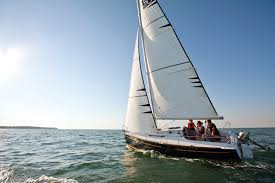
The safety measures that we have to carry on board according to the regulations depend on the navigation zone that our license allows us.
We are going to detail the mandatory safety equipment for the most demanded titles in Marinemax boats: Navigation License (Zone 6), Basic Navigation Skipper (Zone 5), Recreational Boats Skipper (Zone 4).
Navigation License (Zone 6):
- Life jackets of 100 Newton buoyancy.
- First Aid Kit Nº4
- Emergency tiller, for sailboats and single engine boats (except outboard engines).
- Hand flares: 3 units with red light.
- Hand fog horn, but if we prefer it with compressed air, we have to carry a spare.
- Mooring rope
- Spanish flag or the flag of the country where the boat is flying the flag.
- Helicoidal or nautical signal mirror.
- Anchorage
- Boat anchor
- Oar for boats of 8 meters.
- Puncture repair kit and inflator (if the boat is inflatable).
- 21 B type fire extinguisher.
- Bilge bucket.
- Manual bilge pump. Automatic can be installed
Basic Navigation Skipper (Zone 5).
- 100 Newton buoyancy life jackets.
- Emergency tiller, for sailboats and single engine boats (except outboard engines).
- First Aid Kit No. 4
- Hand flares: 3 units with red light.
- Manual fog horn, but if we prefer it with compressed air, we have to carry a spare.
- Mooring lines
- Spanish flag or the flag of the country where we have the Marinemax boats.
- Helical mirror or nautical signal mirror.
- Anchorage
- Bichero
- Rowing oar for boats 8 meters.
- Puncture repair kit and inflator (if the boat is inflatable).
- 21 B type fire extinguisher.
- Bilge bucket
- Manual bilge pump. Can be installed autonomously
Recreational Craft Skipper (Zone 4)
- Life jackets of 150 Newton buoyancy.
- One life ring with light and tail ring.
- Emergency tiller, for sailboats and single-engine boats (except outboard engines).
- First Aid Kit No. 4
- Hand flares 6 units with red light.
- 1 orange floating smoke signal.
- Rockets with red light and parachute.
- One steering compass
- Binoculars.
- Nautical charts and nautical books (International Code of Signals, Pilot’s Guide, First Aid, Lighthouses).
- Watertight flashlight (batteries and spare bulb)
- Signal code (if radio communication equipment is installed).
- Radar reflector (non-metal boats)
- Manual fog horn, but if we prefer compressed air, we must carry a spare.
- Mooring lines
- Flag of Spain or of the country where the boat is flagged.
- Helicoidal or nautical signal mirror.
- Anchorage
- Boat anchor
- Oar, for boats 8 meters.
- Puncture repair kit and inflator (if the boat is inflatable).
- 21 B type fire extinguisher
- Bilge bucket with a capacity of 7 liters.
- Manual bilge pump. Autonomous can be installed
- VHF VHF radio equipment.
Other tips
As a continuation of the last advice regarding the preparation of material to go sailing, it is very important that during navigation the people on board are hydrated, use sunscreen.
Whether you are sailing alone or not, it is important to always transmit a calm and responsible attitude, this will make them feel confident and calm in the case of crew and/or guests on board.
During navigation it is important to maintain a constant visual vigilance both around you and the radar to avoid collisions at sea.
Nowadays and more and more users with qualifications, but without boat make use of pleasure boats for rent with or without skipper to enjoy with friends / as, family… Is in the latter case, rent without skipper, in which it is important if we want to take a swim in a cove / beach or offshore always be someone on board, because a blow of sea can take us away from our boat.
Although if we follow the advice/guidelines given above we should not have any problems during navigation, it is known that the weather is very changeable so, if the weather changes to bad, it is vital that all those on board put on life jackets, although it is advisable to keep them on throughout the journey from the time of embarking on Marinemax boats.
The minimum number of people required will remain at the helm or on deck, while the rest of the people will remain under cover and seated.
Then, we prepare the boat by removing all those loose objects to avoid, at a given moment, for example: that a wave shakes us, can hit us, make us stumble… We will close hatches, hatches and adjust the speed and course depending on the situation.